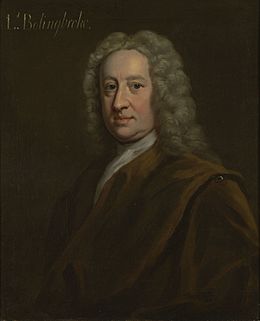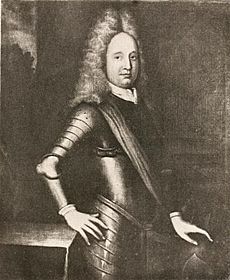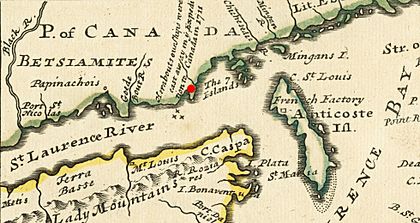Quebec expedition (1711) facts for kids

|
|
| Shipwreck summary | |
|---|---|
| Date | 22 August 1711 |
| Summary | navigation accident |
| Place | St. Lawrence River 49°38′15″N 67°10′30″W / 49.63750°N 67.17500°W |
| Fatalities | about 890 (705 soldiers, 150 sailors, 35 women) |
| Airline/user | Royal Navy |
| Flying to | Quebec, New France |
The Quebec expedition, also known as the Walker expedition to Quebec, was a big plan by the British to attack Quebec in 1711. Quebec was the main city in New France (which is now part of Canada). This happened during Queen Anne's War, which was part of a bigger war called the War of Spanish Succession.
Sadly, the expedition failed. Seven transport ships and one supply ship crashed and sank. About 850 soldiers drowned. This made it one of the worst naval disasters in British history.
The British government, led by Robert Harley, planned this mission. They wanted to focus more on their navy's strength. The leaders, Admiral Hovenden Walker and General John Hill, were chosen because of their political connections. The plan was kept very secret, even from the navy's own leaders! But French spies found out and warned Quebec.
The expedition expected to get all its supplies in Boston, the capital of colonial Massachusetts. But Boston wasn't ready for so many soldiers and sailors. Local officials had to work very hard to gather enough food and supplies. Admiral Walker also struggled to find experienced pilots and good maps for the Saint Lawrence River.
The fleet reached the Gulf of Saint Lawrence safely. But then, thick fog, tricky currents, and strong winds pushed the ships towards the north shore of the river. Many ships crashed near a place now called Pointe-aux-Anglais. After this terrible accident, Admiral Walker gave up on the mission and sailed back to England. Even though it failed, the British government continued to focus on building a strong navy.
Contents
Why Did the Quebec Expedition Happen?
In 1710, during the War of Spanish Succession, British soldiers and American colonists captured a French fort in Acadia (now Annapolis Royal, Nova Scotia). Francis Nicholson, who led that victory, went to London. He and Jeremiah Dummer, who represented Massachusetts, pushed for a new attack on Quebec, the capital of New France.

At this time, the British government was changing. In August 1710, Robert Harley became the new chief minister. He wanted to change Britain's military strategy. He believed in a "blue water" policy, which meant making the navy very strong. This would mean spending less on the army. Harley wanted a big victory to show his new plan was working. So, he approved plans for both a land and sea attack on Quebec. Harley got sick, so his Secretary of State, Henry St. John, did most of the organizing.
The plan was similar to one suggested by Samuel Vetch in 1708. The main attack would be by sea, carrying British soldiers and colonial troops. Rear Admiral Sir Hovenden Walker was put in charge of the sea part. Brigadier John Hill commanded the soldiers. Walker was chosen partly because he was friends with St. John and shared his political views. Hill was chosen because he was the brother of Queen Anne's close friend, Abigail Masham. Five army regiments from Europe were added to two from Britain, making about 5,000 soldiers. These troops sailed from England in April and May 1711. Their destination was a big secret.
Getting Ready in Boston
Francis Nicholson arrived in Boston in June 1711 with the expedition plans. Governors from other colonies quickly met in New London, Connecticut. The naval part of the expedition would include local soldiers from New England. Meanwhile, Nicholson would lead another group of colonial soldiers from New York up the Hudson River to attack Montreal. The New England soldiers joining Walker's fleet were led by Samuel Vetch. They had 1,500 men, mostly from Massachusetts.
The fleet reached Boston on June 24. The soldiers got off the ships at Noddle's Island (where Logan International Airport is today). This was the biggest British force ever to cross the Atlantic Ocean. The fleet had left England without enough supplies, expecting to get everything in Boston. But Boston's population was smaller than the number of soldiers and sailors! It was a huge job to feed everyone. New laws were made to stop merchants from raising prices too much. Enough supplies were finally gathered. Other laws were passed to punish anyone helping soldiers who tried to run away. It seems many soldiers wanted to stay in the colonies!
While in Boston, Admiral Walker tried to find pilots who knew the Saint Lawrence River. To his surprise, no one came forward. Even Captain Cyprian Southack, a famous navigator, said he had never been past the river's mouth. Walker planned to rely on a French pilot he had picked up earlier. But Samuel Vetch didn't trust this Frenchman, calling him "ignorant, pretending, idle, drunken." Walker also forced a captured French captain, Jean Paradis, to be a navigator. The maps Walker had were not very detailed for the mouth of the Saint Lawrence. He also got a journal from Sir William Phips's 1690 expedition to Quebec, but it didn't help much. Walker talked to some people from Phips's trip, but their stories were vague. These worries made him send his biggest ships away, and he moved his flag to a smaller ship, the Edgar.
The Disaster Strikes
On July 30, the fleet left Boston. It had British and colonial ships, including nine warships, two bomb vessels, and 60 transport and supply ships. There were 7,500 soldiers and about 6,000 sailors. By August 3, the fleet reached Nova Scotia. Samuel Vetch guided the ships around Cape Breton Island and into the Gulf of Saint Lawrence.
On the morning of August 18, as the expedition was about to enter the Saint Lawrence River, a strong wind blew from the northwest. Walker had to find shelter in Gaspé Bay. On August 20, the wind changed, and he slowly moved past Anticosti Island. Then the wind died, and thick fog covered everything. By August 22, the wind picked up from the southeast, and the fog sometimes cleared, but not enough to see land. The fleet was west of Anticosti, where the Saint Lawrence River was about 70 miles (113 km) wide. But the river narrowed sharply ahead, and the North Shore turned almost north–south. This area, near Pointe-aux-Anglais, has small islands and many rocky shallows. After talking to his pilots, Walker ordered the fleet to head southwest around 8:00 pm.
Walker thought he was in the middle of the river. But he was actually about 20 miles (32 km) north of where he should have been. Strong currents were pushing his ships towards the northwest. The easterly wind was slowly pushing the fleet towards the rocky north–south shore near Île-aux-Oeufs (Egg Island). When Captain Paddon told Walker that land was sighted around 10:30 pm, Walker thought it was the south shore. He ordered the fleet to turn around and sail in the other direction before he went to bed. This turn put the fleet on a more northerly path. A few minutes later, an army captain named Goddard woke Walker, saying he saw waves crashing ahead. Walker didn't listen at first, but Goddard insisted that the admiral "come upon deck myself, or we should certainly be lost."
Walker came on deck in his robe. He saw that the ship was being pushed towards the western shore by the east wind. The French navigator explained where they were. Walker immediately ordered the anchor ropes cut and tried to sail against the wind to escape. Two warships, Montague and Windsor, had more trouble. They ended up anchored in a dangerous spot, surrounded by crashing waves. All night, Walker heard cries for help. When the fog lifted, he could see ships breaking apart on the rocks. One person from New England wrote that he could "hear the shrieks of the sinking, drowning, departing souls." Around 2:00 am, the wind calmed down and then shifted to the northwest. Most of the fleet managed to get away from the shore.
It took three days to find out how bad the disaster was. The fleet searched for survivors. Seven transport ships and one supply ship were lost. Walker first reported that 884 soldiers died. Later, this number was changed to 740, including women who were with some of the army units. Historian Gerald Graham thinks about 150 sailors also died. After rescuing everyone they could, Walker and Hill held a meeting on August 25. After talking to several pilots, including Samuel Vetch, they decided to stop the expedition. They said it was "by reason of the Ignorance of the Pilots." Vetch openly blamed Walker, saying the disaster was not due to hard navigation, but to the "wrong course we steered."
The fleet sailed down the Gulf of Saint Lawrence and anchored at Spanish River (now Sydney, Nova Scotia) on September 4. They discussed whether to attack the French at Plaisance. But it was getting late in the year, they didn't have enough supplies for winter, and there were rumors of strong defenses at Plaisance. So, the council decided not to attack and sailed for England.
The Return Journey
Francis Nicholson's land expedition found out about the naval disaster when they were near Lake George. Nicholson stopped his expedition. He was so angry that he reportedly threw his wig on the ground.
The expedition's luck didn't get better on the way back. Walker had asked for the ship HMS Feversham and any supply ships to join him. But without him knowing, the Feversham and three transport ships (Joseph, Mary, and Neptune) crashed on the coast of Cape Breton on October 7. More than 100 men were lost. The main fleet returned to Portsmouth on October 10. Walker's flagship, the Edgar, blew up a few days later. This might have been due to gunpowder being handled incorrectly. Walker lost many papers in the blast, and he claimed that William Phips's journal was lost too.
Even though the expedition was a huge failure, the political problems were not too bad. It was a setback for Robert Harley's "blue water" policy. But Harley still continued to focus on the navy. Since the current government had planned the mission, they weren't very interested in finding out exactly why it failed. The queen welcomed Walker kindly, and both he and Hill were given new commands. Walker later wrote a detailed account of the expedition. He lost his rank in 1715 and died in 1728.
Many people in England blamed the colonies for not supporting the expedition enough. They said the colonists were stingy and stubborn. But in the colonies, Nicholson and Governor Dudley blamed Walker instead. The relationship between the military leaders and the colonists was often difficult. One of Hill's officers wrote about the "ill Nature and Sowerness of these People." He also said that if the colonists weren't controlled better, they would "grow more stiff and disobedient every Day." Colonists were upset that Walker and Hill were not punished for the failure.
French Response
French officials knew as early as March 1711 that Nicholson was planning an attack on Quebec. They also knew about Hill's soldiers, but they didn't know where they were going until July. The Governor-general of New France, the marquis de Vaudreuil, sent Louis Denys de La Ronde to Boston in early June. He was supposed to arrange a prisoner exchange. But he also had secret orders to try to convince the colonial leaders not to help the British expeditions. La Ronde arrived in Boston on June 8, the same day as Nicholson. He didn't seem to succeed in changing colonial opinions. Nicholson became suspicious of him and had him arrested. When copies of La Ronde's secret orders were found on a captured French ship, he was held in Boston until November.
Governor Vaudreuil was warned again in August that attacks on Quebec and Montreal were being planned. He called out his militia, gathered local Native American allies, and prepared his defenses. The whole colony got ready for war. In mid-October, word reached Quebec that large ships were approaching, making everyone even more nervous. It turned out they were French ships. On board was a scout Vaudreuil had sent downriver on September 19 to watch for the British fleet. The scout reported finding the wreckage of seven ships and about 1,500 bodies. Local people were already taking things from the wreckage. The colony then organized a formal salvage operation. They recovered items like anchors, chains, tents, and cannons. These items were then sold at auction.
Land Forces Involved
- Queen's Royal Sea Service Foot (4th)
- Stanhope's Sea Service Foot (11th)
- Livesays' Sea Service Foot (12th)
- Handasyde's Sea Service Foot (22nd)
- Wetham's Sea Service Foot (27th) (Irish Establishment)
- Saunderson's 1st Marines (30th)
- Donegal's Marines (35th) (Irish Establishment)
- Charlemont's Sea Service Foot (36th) (Irish Establishment)
- Meredeth's Sea Service Foot (37th) (Irish Establishment)
- One company each from:
- Villier's 2nd Marines (31st) (Irish Establishment)
- Borr's 3rd Marines (32nd)
- Mordaunts' Marines
- Holt's Marines
- Shannon's Marines
- Vetch's Regiment, Colonel Samuel Vetch (Massachusetts)
- Walton's Regiment, Colonel Shadrach Walton (New Hampshire-Rhode Island)
Warships in the Fleet
| Ship | Guns | Commander | Notes |
|---|---|---|---|
| HMS Edgar | 70 | Rear-Admiral Hovenden Walker Captain George Paddon |
Paddon took command in Boston; exploded at Spithead on October 15. |
| HMS Swiftsure | 70 | Captain Joseph Soanes | Soanes became captain of Swiftsure in Boston. |
| HMS Monmouth | 70 | Captain John Mitchell | |
| HMS Sunderland | 60 | Captain John Cockburn | |
| HMS Kingston | 60 | Captain Joseph Winder | |
| HMS Montague | 60 | Captain George Walton | |
| HMS Windsor | 60 | Captain Robert Arris | Arris took command of Windsor in Boston. This ship carried General Hill's flag. |
| HMS Dunkirk | 60 | Captain Henry Gore | Previous commander, Captain Thomas Butler, was dismissed on June 27. |
| HMS Leopard | 50 | Captain Isaac Cook | |
| HMS Enterprise | 40 | Captain Nicholas Smith | |
| HMS Sapphire | 40 | Captain Augustine Rouse | |
| HMS Lowestoffe | 32 | Captain George Gordon | |
| HMS Tryton Prize | 30 | Commander Richard Burlington | |
| HMS Basilisk | – | Commander Robert Harward | Bomb vessel (a ship that fired bombs) |
| HMS Granado | – | Commander James Grainger | Bomb vessel |
| HMS Feversham | 36 | Captain Robert Paston | Sent to escort supply ships from Virginia; lost in a storm on October 7. |
| HMS Torbay | 80 | Captain James Moody | On separate duty. |
| HMS Devonshire | 80 | Captain John Cooper | On separate duty; Cooper took command of Devonshire in Boston. |
| HMS Humber | 80 | Captain Richard Culliford | On separate duty. |
| HMS Chester | 50 | Captain Thomas Mathews | On separate duty. |
| HMS Diamond | 40 | Captain Tobias Lisle | On separate duty. |
| HMS Bedford Galley | 34 | Captain Andrew Lay | On separate duty. |
| HMS Experiment | 40 | Captain Matthew Elford | On separate duty. |


